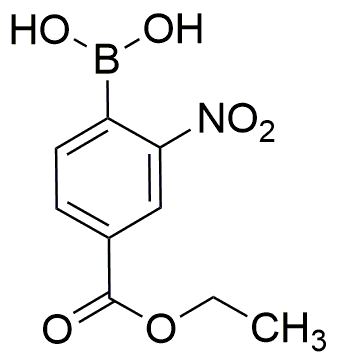4-Ethoxycarbonyl-2-nitrophenylboronic acid is widely utilized in research focused on:
- Synthetic Chemistry: This compound serves as a versatile building block in organic synthesis, particularly in the formation of complex molecules, making it invaluable for chemists developing new pharmaceuticals.
- Medicinal Chemistry: It plays a crucial role in the design of boron-containing drugs, which can enhance the efficacy of treatments for various diseases, including cancer, by targeting specific biological pathways.
- Bioconjugation: The compound is used in bioconjugation techniques, allowing researchers to attach biomolecules to surfaces or other molecules, which is essential in the development of targeted drug delivery systems.
- Fluorescent Probes: Its unique properties make it suitable for creating fluorescent probes, which are used in imaging techniques to study biological processes in real-time.
- Environmental Chemistry: This chemical is applied in the detection and remediation of pollutants, helping to develop methods for monitoring environmental contaminants effectively.
Informations générales
Propriétés
Sécurité et réglementation
Applications
4-Ethoxycarbonyl-2-nitrophenylboronic acid is widely utilized in research focused on:
- Synthetic Chemistry: This compound serves as a versatile building block in organic synthesis, particularly in the formation of complex molecules, making it invaluable for chemists developing new pharmaceuticals.
- Medicinal Chemistry: It plays a crucial role in the design of boron-containing drugs, which can enhance the efficacy of treatments for various diseases, including cancer, by targeting specific biological pathways.
- Bioconjugation: The compound is used in bioconjugation techniques, allowing researchers to attach biomolecules to surfaces or other molecules, which is essential in the development of targeted drug delivery systems.
- Fluorescent Probes: Its unique properties make it suitable for creating fluorescent probes, which are used in imaging techniques to study biological processes in real-time.
- Environmental Chemistry: This chemical is applied in the detection and remediation of pollutants, helping to develop methods for monitoring environmental contaminants effectively.
Documents
Fiches de données de sécurité (FDS)
La FDS fournit des informations de sécurité complètes sur la manipulation, le stockage et l’élimination du produit.
Spécifications du produit (PS)
Le PS fournit une description complète des propriétés du produit, notamment sa composition chimique, son état physique, sa pureté et les exigences de stockage. Il détaille également les plages de qualité acceptables et les applications prévues du produit.
Certificats d'analyse (COA)
Recherchez des certificats d'analyse (COA) en saisissant le numéro de lot du produit. Les numéros de lot et de lot se trouvent sur l'étiquette d'un produit, après les mots « Lot » ou « Lot de fabrication ».
Numéro de catalogue
Numéro de lot/série
Certificats d'origine (COO)
Ce certificat d'exploitation confirme le pays dans lequel le produit a été fabriqué, et détaille également les matériaux et composants utilisés et s'il est issu de sources naturelles, synthétiques ou autres sources spécifiques. Ce certificat peut être requis pour les douanes, le commerce et la conformité réglementaire.
Numéro de catalogue
Numéro de lot/série
Fiches de données de sécurité (FDS)
La FDS fournit des informations de sécurité complètes sur la manipulation, le stockage et l’élimination du produit.
DownloadSpécifications du produit (PS)
Le PS fournit une description complète des propriétés du produit, notamment sa composition chimique, son état physique, sa pureté et les exigences de stockage. Il détaille également les plages de qualité acceptables et les applications prévues du produit.
DownloadCertificats d'analyse (COA)
Recherchez des certificats d'analyse (COA) en saisissant le numéro de lot du produit. Les numéros de lot et de lot se trouvent sur l'étiquette d'un produit, après les mots « Lot » ou « Lot de fabrication ».
Numéro de catalogue
Numéro de lot/série
Certificats d'origine (COO)
Ce certificat d'exploitation confirme le pays dans lequel le produit a été fabriqué, et détaille également les matériaux et composants utilisés et s'il est issu de sources naturelles, synthétiques ou autres sources spécifiques. Ce certificat peut être requis pour les douanes, le commerce et la conformité réglementaire.


